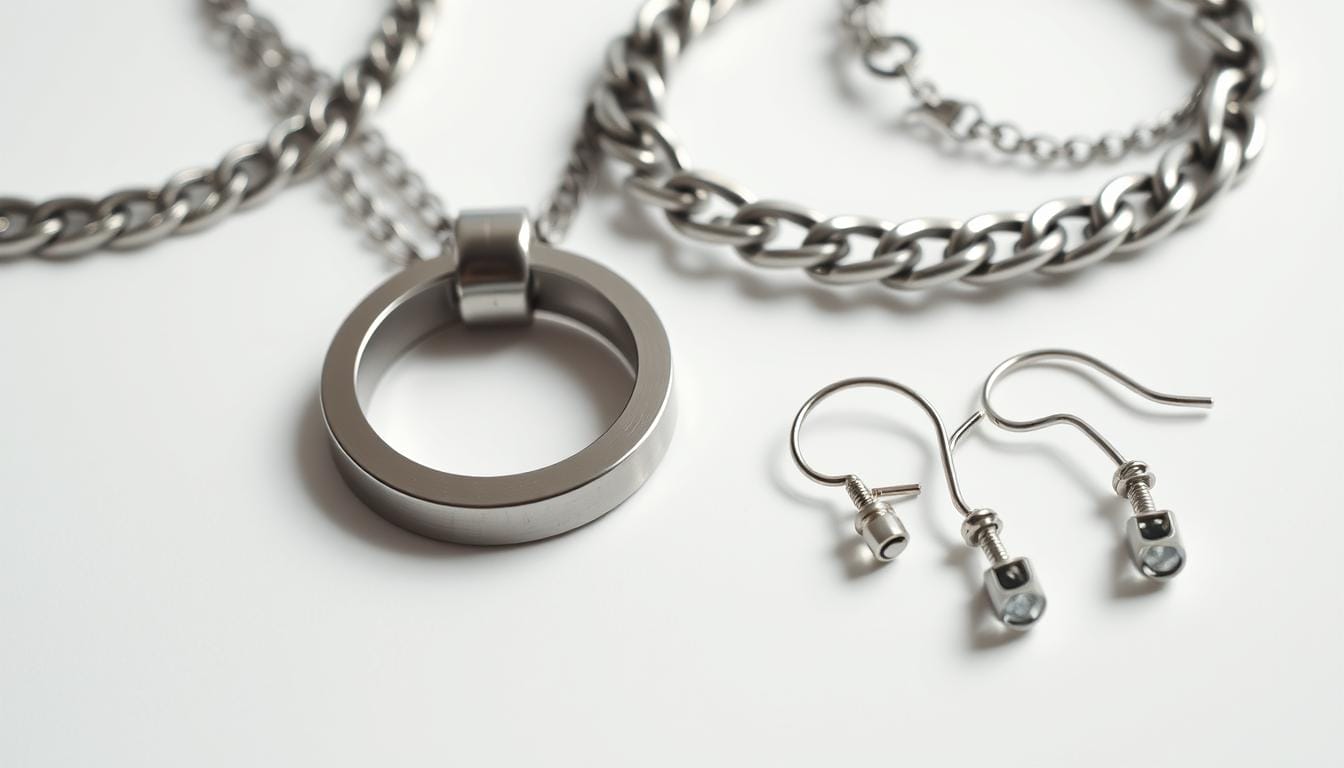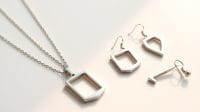Can one simple routine keep your metal pieces bright and lasting for years? This introduction offers clear, pro-level guidance to preserve durability and shine without complex tools.
The guide explains what the alloy is and why a chromium-driven passive film matters: that thin oxide layer prevents corrosion and keeps finishes intact. It highlights common grades—304 and 316L—and how marks like “SS,” “304,” or “316L” help assess quality.
Readers learn straightforward cleaning: warm water, mild soap, and a soft cloth for routine upkeep; a baking soda paste for deeper cleaning. Avoid harsh chemicals and chlorine to protect the protective film and preserve style.
Outcome: with monthly cleaning cadence and a small care kit—soft cloth, mild soap, and a tray—people can confidently maintain pieces and match effort to time available. How often do you wipe down your jewelry after a long day?
Why stainless steel jewelry maintenance matters today
Daily habits determine whether metal pieces keep their factory finish or slowly dull. Even alloys that resist rust rely on a thin oxide film for protection.
Why care matters: exposure to water, sweat, and airborne grime builds up during a typical day. That film can wear when salts and particulates linger, so a quick wipe prevents long-term wear.
Risk factors include chlorine and strong household chemicals. These agents can weaken the oxide layer and raise the chance of corrosion and lost luster.
- Cost-effectiveness: routine care avoids costly restoration or premature replacement of pieces.
- Convenience: short rinses, soft drying, and monthly cleaning keep finishes intact.
- Consistency: small, daily steps stop oil and residue buildup that attracts dirt.
- Active people benefit most—post-workout rinses remove salts that dull surfaces.
Takeaway: “stainless” is not “care-free.” Minimal, regular maintenance preserves aesthetic appeal and long-term durability, aligning with buyers’ goals for lasting, photo-ready pieces.
The case for durability, corrosion resistance, and everyday value
A chromium-rich alloy forms a thin, self-healing oxide that blocks rust and helps maintain long-term shine. This protective chemistry starts working as soon as the metal meets air; minor scratches re-passivate on their own.
Practical metallurgy: alloys with at least 10.5% chromium create that protective layer. 316L adds molybdenum for better chloride resistance near pools or the ocean, while 304 performs well in urban and office use.
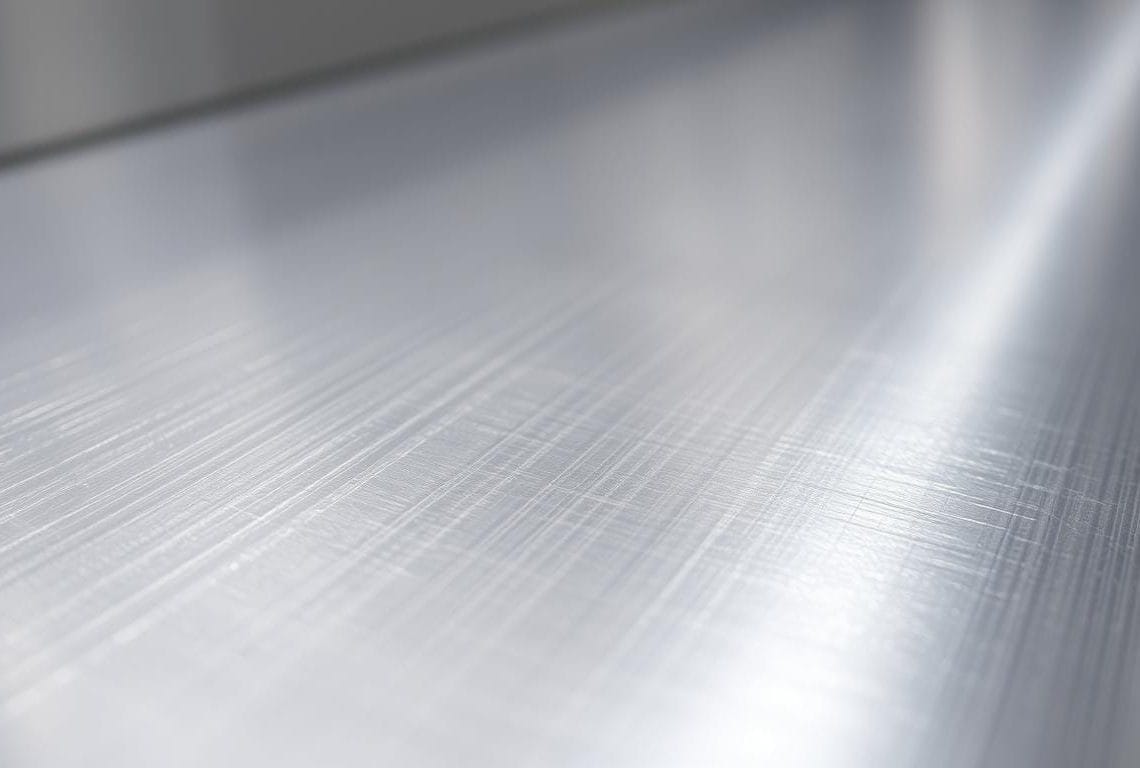
Everyday value: compared with softer metals, this construction resists knocks and abrasions and keeps a polished or brushed finish longer. Buyers get strong appearance retention without premium pricing.
Why it matters in daily wear
- Finish resilience: brushed and polished faces mask minor marks better than many alternatives.
- Self-healing: the chromium oxide reforms quickly in air after small abrasions.
- Care tip: simple cleaning and full drying preserves the protective layer and consistent shine.
Note: avoid chlorine and strong acids to protect the protective layer and extend lifespan of any metal piece, including pieces of stainless steel used as everyday jewelry.
Potential drawbacks to weigh before you buy
Not every advantage is without cost—understanding practical downsides helps set realistic expectations. This brief look helps buyers match product choice to lifestyle.

Hard-to-resize rings
The material’s hardness gives long wear but makes resizing difficult. Confirm ring fit before purchase and favor sellers with easy exchanges.
Chlorine and chemical exposure
Chlorine in pools and common household chemicals can attack the finish and raise the risk of corrosion. Remove pieces before swims or heavy cleaning.
Finish restoration and scratches
Deep scratches are harder to restore than on softer metals. Light touch-ups work, but full repolish may need professional tools and skills.
- Comfort trade-off: heavier designs feel substantial but may not suit all users.
- Quality checks: inspect clasps, hinges, and links to prevent wear points.
- Value lens: upfront value is strong, but resale appreciation is limited compared to precious options.
- Buyer tip: choose 316L when chemical resistance matters and pick brands with multiple sizes or exchange policies.
Understanding grades, composition, and markings
Simple stamps and numbers tell a detailed story about corrosion resistance and long-term care. Read marks to match performance to your routine and environment.

304 vs. 316L: chromium, nickel, and low-carbon differences
Grade 304 (often marked 18/8) contains about 18% chromium and 8% nickel. That mix stabilizes the austenitic structure and offers good corrosion resistance for everyday indoor wear.
By contrast, 316L is a low-carbon variant with added molybdenum. The lower carbon level reduces carbide precipitation at welds and edges, and molybdenum improves pitting resistance in chloride-rich settings.
What stamps like SS, 304, and 316L really mean
- SS / S.Steel: a compact hallmark signaling the alloy family; useful but general.
- 304: reliable for daily urban use—good formability and finish longevity thanks to nickel.
- 316L: preferred for coastal, humid, or sweat-heavy conditions because of better chloride resistance.
Note: absence of a stamp does not prove absence of the material, but clear markings help buyers verify claims. Also, a “sterling” or “925” mark denotes silver, not stainless steel—check stamps carefully before purchase.
Takeaway: knowing grade, chromium content, and nickel’s role guides care choices and storage. Informed buyers balance performance, look, and budget when selecting pieces.
How to identify genuine stainless steel jewelry
A few quick checks will separate authentic metal pieces from low-cost imitations. Use simple tools and a clear routine to verify composition before purchase.
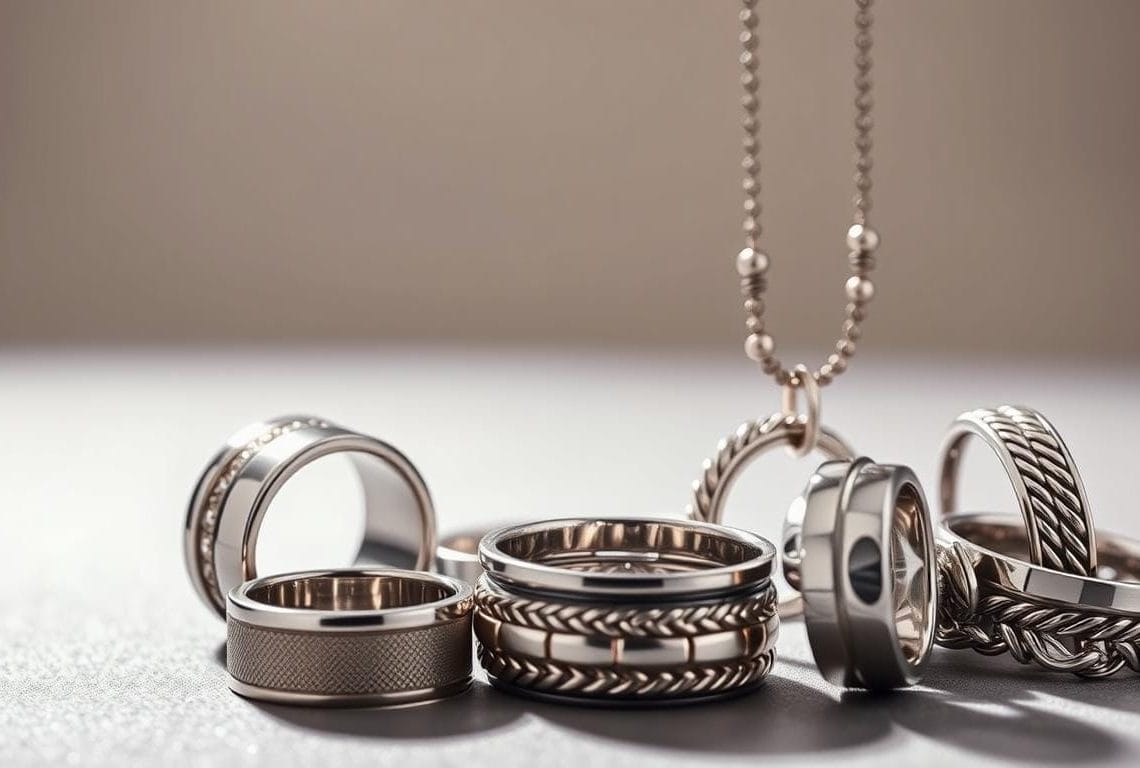
Magnet, weight-in-hand, and finish checks
Start with a magnet: expect a slight pull for many grades, though some alloys show weak response. A non-response does not guarantee a fake — manufacturing can alter magnetic behavior.
Handle the piece: genuine steel jewelry feels denser than plated brass or aluminum. Check the finish for uniform brushed or polished grain — no flaking, no peeling.
Engraved grade markings and where to find them
Look for stamps on inner ring bands, clasp backs, tag plates, or bracelet closures. Marks like 316L, 304, “SS,” or “S.Steel” are common indicators of grade and quality.
Visual and chemical resistance cues
Authentic pieces show a consistent silvery-grey hue and resist tarnish after brief water exposure. For professional checks, a discreet acid spot test shows no color change on true alloys.
- Combine tests: magnet + markings + finish for higher confidence.
- Shop tip: sellers who show clear hallmarks and macro photos usually provide better sourcing.
- When unsure: a jeweler can confirm metal content with lab tests.
For more on long-term care and tarnish resistance, see this concise guide: does stainless steel jewelry tarnish.
Daily care routine: warm water, mild soap, and a soft cloth
Simple, regular care is the fastest way to maintain a lasting finish on everyday pieces. A short routine prevents dirt and oils from building up and keeps the protective layer intact.

Gentle cleaning that preserves the protective layer
Rinse items briefly with warm water, add a few drops of mild soap, and wipe with a soft, lint-free cloth following the grain. This removes grime without abrading the surface.
Tip: use neutral pH soaps and avoid scented cleaners that contain solvents or dyes.
Microfiber maintenance between washes
For quick daily touch-ups, buff pieces with a dry microfiber cloth to lift fingerprints and dust. This saves time and reduces the need for frequent wet cleaning.
- Build a simple routine: rinse with warm water, add soap, and wipe along the grain.
- Direction matters: dry in the grain direction to limit micro-abrasions on brushed finishes.
- Dry thoroughly: pat dry to avoid mineral spots and trapped moisture.
- Access details: use a soft-bristled brush for crevices in chains and clasps, then rinse and dry.
- Storage: place completely dry pieces in soft pouches to prevent moisture build-up.
Outcome: quick day-to-day wipe-downs plus a regular soap-and-water session keep stainless steel jewelry bright with minimal effort. For specific watch care routines, see cleaning a watch.
Deep cleaning and restoring shine without scratches
A careful paste-and-rinse method brings back bright surfaces without harsh abrasion. This approach targets stubborn buildup while protecting finishes and minimizing risk of micro-scratches.
Baking soda paste for stubborn buildup
Mix a small mound of baking soda with a few drops of water to form a spreadable paste. Apply the paste with a soft cloth and rub gently along the grain—use light pressure only.

- Mix: baking soda + a few drops of water to a toothpaste-like consistency.
- Apply: use a soft, lint-free cloth; avoid paper towels and abrasive pastes that cause scratches.
- For chains: use a soft brush lightly, then rinse well to clear trapped paste.
- Repeat: if deposits remain, repeat the process instead of increasing pressure.
Rinsing and thorough drying to prevent residue
Rinse under warm water until all paste is gone—any residue will dull the finish. Pat dry immediately with a lint-free cloth and finish with a microfiber buff to restore shine.
Avoid toothpaste, paper towels, and aggressive polishing cloths. These introduce abrasives that can leave fine scratches on polished or brushed pieces. Keep a simple kit: mild soap, warm water, and a soft cloth for best results.
What to avoid: harsh chemicals, chlorine, and abrasive tools
Some routine cleaning habits do more harm than good—know which to stop now. Brief, repeated contact with strong agents can erode the protective layer and reduce long-term shine.
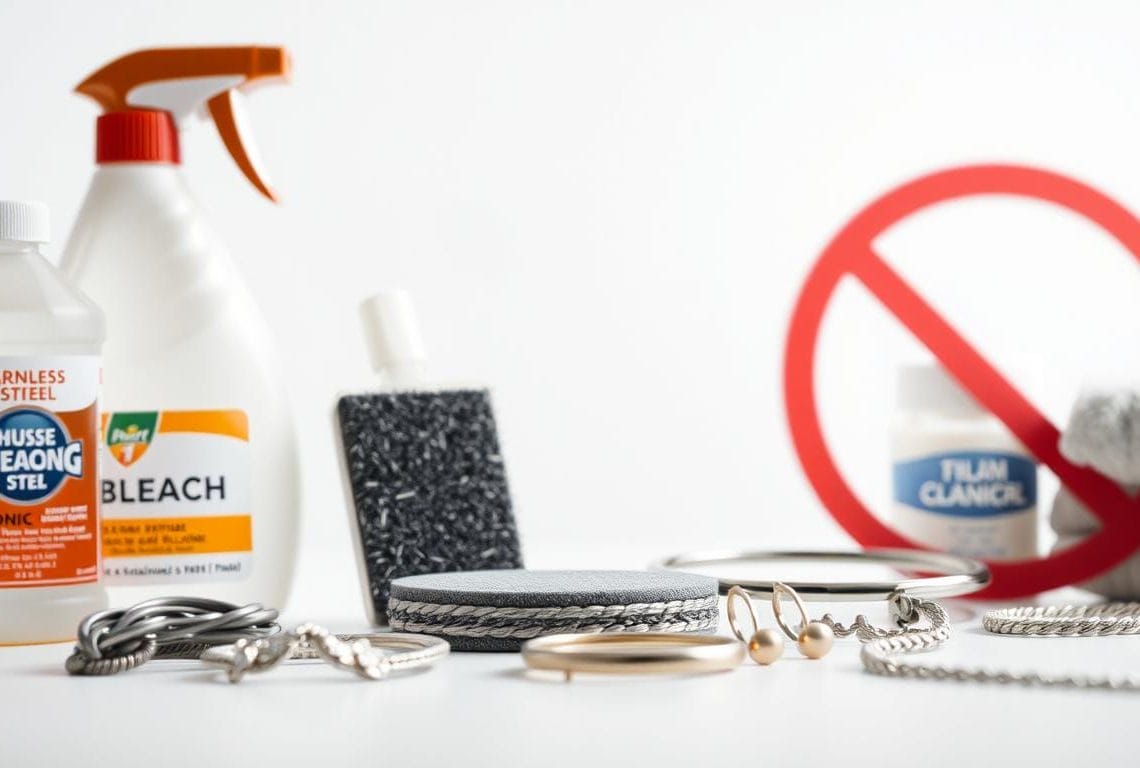
Pools, bleach, and strong cleaners that degrade luster
Remove rings and necklaces before entering chlorinated pools or hot tubs. Chlorine accelerates surface attack and can cause visible corrosion over time.
Keep bleach and commercial degreasers well away from metal pieces. Even brief splashes can undermine the oxide layer that preserves finish and quality.
Skip toothpaste, paper towels, and aggressive polishing cloths
Avoid toothpaste and rough paper towels for daily wipes—they act as abrasives and can mar polished faces. Do not use polishing cloths made for softer metals; they may be too harsh.
- Rinse with clean water and dry promptly if accidental contact occurs.
- Store cleaning agents away from storage trays and teach other people in the home to avoid spraying near open pieces.
- When in doubt, choose mild cleaning and microfiber techniques to protect appearance and prevent repeated chemical damage.
Preventing scratches and safe storage for rings, bracelets, and necklaces
Small storage choices make the biggest difference in preventing scratches on rings, bracelets, and necklaces. A simple system protects finishes and saves time on repairs.
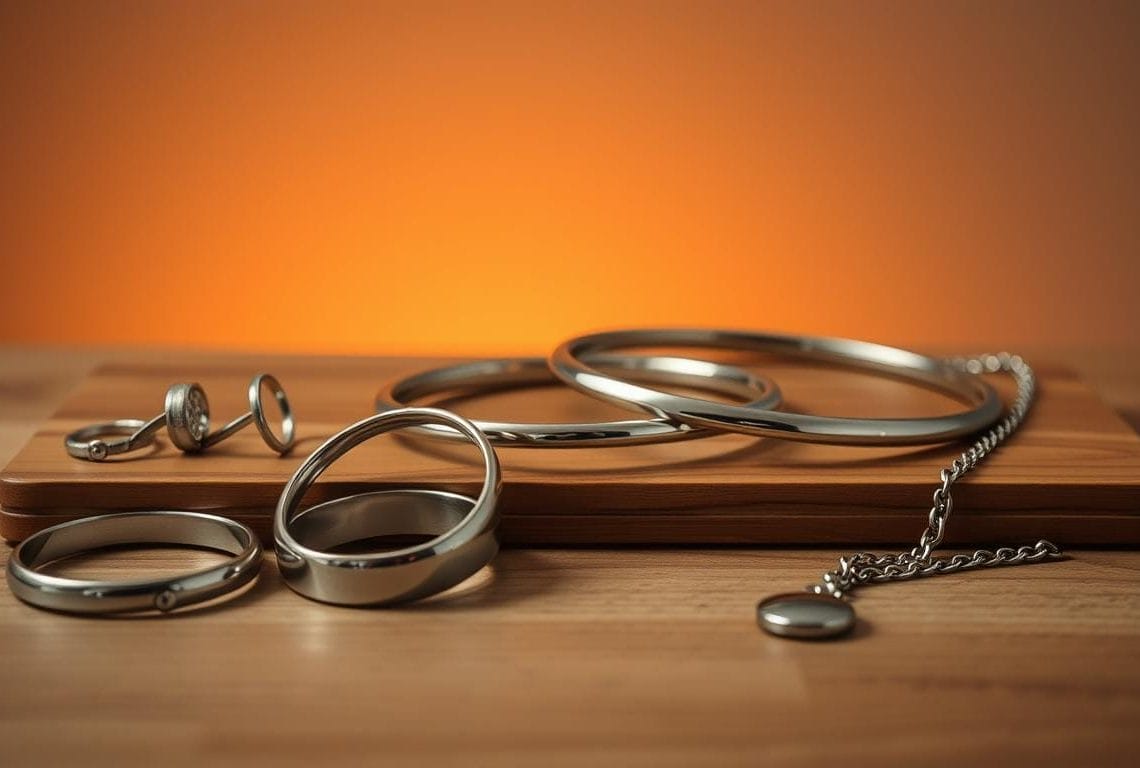
Store separately: use dedicated compartments or soft pouches so items do not rub together. Place a soft cloth in trays to cushion pieces and reduce contact points.
Travel smart: use a roll-up case with individual slots for rings and bracelets to keep separation while on the move. Keep chains clasped during storage to prevent tangling and link abrasion.
- Remove items before high-impact tasks—lifting weights, yard work, or moving furniture—to avoid dings.
- Inspect bracelet and necklace clasps for alignment and tension; fix minor issues early.
- Rotate wear among pieces to spread daily wear and reduce localized scratch buildup.
Wipe fingerprints and sweat from each piece with a soft cloth before storing. Set a weekly 60-second check: glance at prongs and hinge screws to catch wear before it worsens.
Outcome: mindful wear habits and proper separation extend finish life and reduce the need for polishing, keeping jewelry and stainless steel pieces looking their best.
Water, sweat, and the gym: practical wear-and-care guidance
Workouts and wet weather expose pieces to salts and oils that speed dulling without quick post-activity care. A short routine preserves finish and extends durability for people who wear items during a busy day.
When to remove pieces: keep stainless steel jewelry on for most cardio and light gym sessions. Remove rings and bracelets for chlorine pools, abrasive contact, or heavy-impact sports to avoid nicks and compression marks.
Quick post-workout steps
After exercising, wipe each item with a dry microfiber cloth to lift sweat salts that can dull finishes. If residue feels tacky, rinse with water and dry immediately.
- Avoid gripping barbells with rings—this reduces dings and deformation.
- Consider silicone substitutes at the gym when constant wear is needed.
- For outdoor runs, sweat is fine; focus on prompt drying when done.
- If skin irritation appears under snug bracelets, remove briefly and clean both skin and piece.
Pack a small gym care kit: a microfiber cloth, a small zip pouch, and a soft sleeve for temporary storage. Consistent post-workout care keeps steel jewelry looking newer and cuts down later cleaning time.
Skin sensitivity, nickel awareness, and choosing hypoallergenic grades
Choosing the right grade can cut the chance of a skin reaction while preserving corrosion resistance.
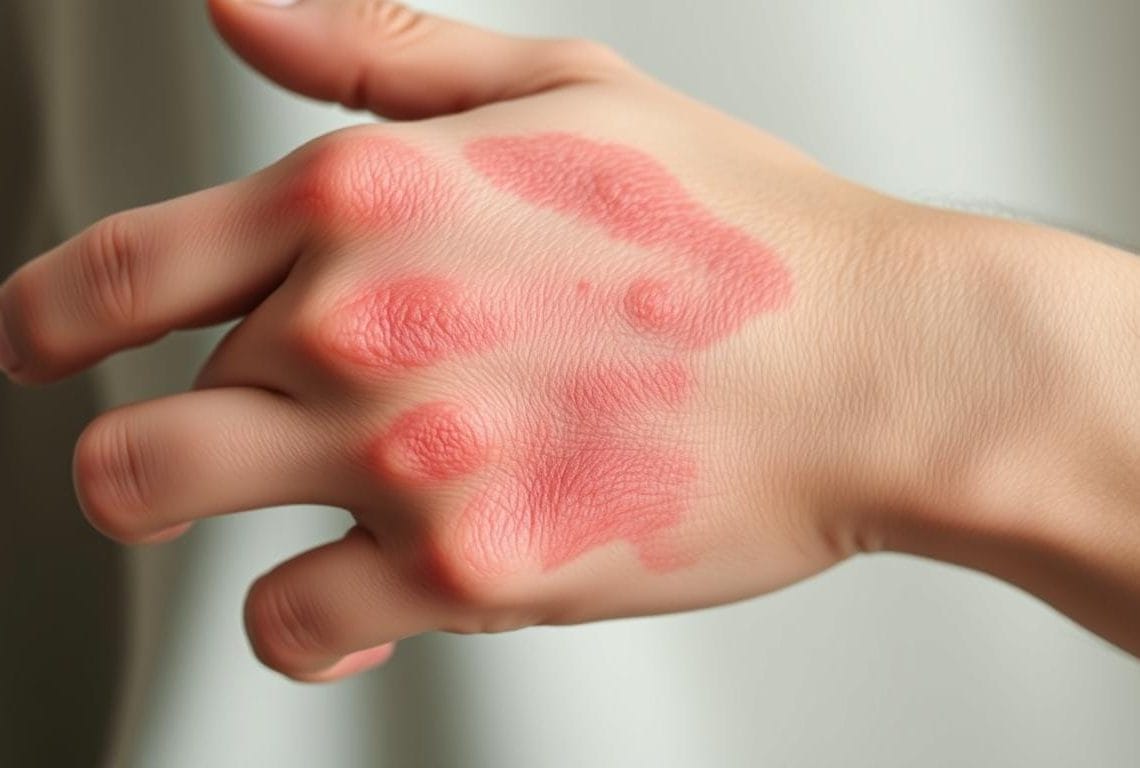
Why nickel matters: nickel improves formability and corrosion resistance in austenitic alloys. That makes pieces easier to shape and more durable for daily wear. It also supports the alloy’s structure so finishes last longer.
Allergy and skin guidance: some people develop contact reactions to nickel. For those users, pick certified hypoallergenic options or verified 316L from reputable makers—this grade is widely used in body-contact applications and lowers the risk of irritation.
- Check product specs and ask sellers for documented alloy data and testing.
- Avoid worn plating—exposed base layers can release unexpected allergens.
- Keep contact areas clean and dry, rotate wear, and choose slightly looser fits to allow airflow.
If irritation occurs, stop wearing the piece and consult a professional. Brands with transparent metallurgy and clear stamps reduce uncertainty. Keep a short journal tracking which grades and finishes suit your skin for safer future purchases.
Stainless steel vs. sterling silver: care, durability, and style
A buyer’s lifestyle usually decides whether low-maintenance durability or classic luster is the better match.
Hardness and scratch resistance compared
Hardness: the alloy typically rates above 5.5 on the Mohs scale, so it resists scratches far better than silver, which sits near 2.5–3.
For rings and heavy-wear necklaces, choose the harder metal to keep surfaces looking newer longer.
Tarnish, corrosion, and long-term shine
Tarnish behavior: sterling silver develops surface tarnish in sulfur-rich air and needs periodic polishing.
By contrast, stainless steel relies on a chromium oxide film to retain shine with simple rinses and wipes.
Fit, sizing challenges, and maintenance over time
Sizing: the harder metal is tougher to resize — jewelers often prefer working with sterling for adjustments.
Maintenance cadence: silver owners plan regular polish cycles. Owners of the harder alloy focus on quick cleaning and occasional deep cleans.
- Hallmarks: look for “925” or “Sterling” on silver; “SS,” “304,” or “316L” on the other metal.
- Style & value: both offer polished and brushed finishes; the harder option gives budget-friendly long-term value, while silver may carry higher intrinsic material worth.
- Selection tip: choose based on desired upkeep, look, and whether frequent resizing is expected.
Conclusion: pick the harder alloy for low-maintenance durability, or choose sterling silver for classic luster and easier resizing — match choice to daily habits and long-term goals.
Styling tips: mix metals, finishes, and everyday pieces
Small styling choices transform everyday metal pieces into a cohesive, modern look. Use contrasts and a clear focal point to craft outfits that feel deliberate and low-effort.
Rings and bracelets: brushed, matte, and glossy looks
Mix finishes to create visual interest. Stack a glossy ring with a brushed band and add a matte bracelet for texture.
Practical tip: brushed surfaces hide fingerprints and show less wear for daily use.
- Balance proportions: pair slim rings with chunkier bracelets to avoid visual clutter.
- Keep a focal point: choose one bold cuff and let smaller rings support it.
- Care-aware choice: textured finishes need routine microfiber wiping to keep details crisp.
Necklaces and engravable designs in silver, gold, black, and rose gold
Choose colorways to match your wardrobe: cool palettes favor silver and black; warm tones pair well with gold and rose gold.
Engravable pendants and ID bracelets add personal meaning—initials or dates make strong gifts.
- Play with finishes: layer matte and polished chains for depth.
- Seasonal rotation: lighter necklaces in summer; bolder chains in fall for fabric contrast.
- Designs to try: single pendant as focal point, supported by fine chains and small studs.
Outcome: thoughtful mixing of metals and finishes elevates everyday wear. With a clear focal piece and balanced accents, anyone can build a cohesive look that endures.
Buyer’s checklist: grades, finish quality, and care accessories
Smart buyers use a quick physical check to confirm grade, finish, and fit. This short checklist helps verify authenticity and long-term value before purchase. It focuses on hallmarks, finish consistency, and mechanical reliability so readers can buy with confidence.
Confirm marks and finish
Verify hallmarks such as 316L, 304, or SS to match corrosion performance to your lifestyle. Inspect brushed grain direction for evenness—irregular grain can signal poor quality or rushed finishing.
Check mechanics and comfort
Test clasps on necklaces and bracelets for smooth action and no lateral play. Examine edges and inner bands for burr-free comfort. Assess weight-in-hand: it should feel substantial without being bulky.
Assemble a basic care kit
- Microfiber cloth for daily wipes.
- Mild soap and warm water for monthly cleaning.
- Soft brush for crevices and tight links.
- Individual pouches to protect stored pieces.
- Set a maintenance calendar: monthly clean, quarterly inspection of moving parts.
- Prefer sellers who share macro photos of hallmarks and finish close-ups.
For product pages and care details, see the manufacturer’s notes and this concise reference on stainless steel jewelry.
Sustainability, recyclability, and long-term care habits
Small, regular habits extend a piece’s life and lower its environmental footprint. This section shows how simple choices keep materials in use longer and reduce waste.
Why it matters: the alloy used in many items is highly recyclable and chemically inert. Near‑100% recovery rates mean fewer raw‑material extractions when pieces are reused or melted down.
Eco-smart routine: monthly cleaning and storage
Adopt a monthly clean: a quick rinse with warm water and a soft microfiber cloth removes buildup without chemicals. This small step prevents intensive restoration and fewer replacements.
- Resource-wise care: use water and a reusable cloth instead of disposable wipes or harsh cleaners.
- Separated storage: keep pieces in individual compartments or pouches to avoid scratches and premature wear.
- Reusable kit: a compact kit — cloth, mild soap, soft brush — cuts single‑use waste and stays useful for years.
People-focused tip: track a simple maintenance log — note cleaning dates and inspections. This habit supports durability and helps owners spot issues early.
Buy responsibly: prefer brands that publish sourcing and grade disclosures. Lifecycle thinking — durable pieces plus steady care — reduces turnover and the environmental cost of frequent buying.
stainless steel jewelry
Modern pieces blend finish options and color plating to suit both casual and formal wardrobes.
Overview: this category covers polished, brushed, matte, and engraved designs with silver, gold, black, and rose-gold tones. Buyers get durable looks that stand up to daily wear.
Styling & fit: layer with silver or gold pieces for balanced stacks. Confirm ring and bracelet sizes before buying—resizing can be difficult with harder metals.
- Authentication: look for marks like SS, 304, or 316L to verify quality.
- Care pillars: mild cleaning, microfiber maintenance, and avoiding harsh chemicals preserve finish.
- Selection tip: choose material jewelry from sellers who publish clear specs and photos.
- Personalization: many designs accept engraving for gifting and ID.
Cross-compare: expect less frequent polishing than silver but a firmer feel and different maintenance needs. For value, these pieces are accessibly priced yet deliver dependable wear across outfits and occasions.
Keep your pieces looking new for years to come
Important: A clear routine that fits your day keeps pieces bright and reduces repair time.
Commit to brief, daily wipe-downs and one monthly cleaning with mild soap and warm water. This simple care preserves shine and cuts long-term effort.
Protect finishes by avoiding chlorine and harsh cleaners. Rinse any exposed item with water and dry it promptly to stop damage. Use a soft microfiber cloth and gentle technique for every piece.
Confirm grade before buying so performance matches your routine. For additional guidance on material selection and maintenance, see stainless steel jewelry care.
